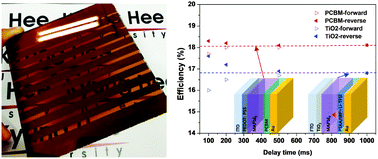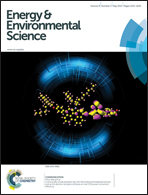Hysteresis-less inverted CH3NH3PbI3 planar perovskite hybrid solar cells with 18.1% power conversion efficiency†
Abstract
Hysteresis-less inverted ITO/PEDOT:PSS/CH3NH3PbI3 (MAPbI3)/PCBM/Au planar hybrid solar cells with 18.1% average power conversion efficiency irrespective of the scan rate were fabricated by depositing dense pinhole-free MAPbI3 perovskite on a PEDOT:PSS/ITO substrate via a single-step spin-coating of solubility controlled MAPbI3 solution. The conductivities of PEDOT:PSS, PCBM, poly(triaryl amine) (PTAA):tert-butylpyrridne (tBP) + Li-bis(trifluoromethanesulfonyl)imide (Li–TFSI), MAPbI3, and TiO2 were 0.014, 0.016, 0.034, 0.015, and 0.00006 mS cm−1, respectively. The average PL lifetimes (τav) of the inverted and normal cell were 1.277 and 1.94 ns, respectively. The diffusion coefficient (Dn) and charge carrier lifetime (τn) for the inverted MAPbI3 planar hybrid solar cells were increased by 1.14-fold and 1.1-fold, respectively, compared with the conventional FTO/TiO2/MAPbI3/PTAA:tBP + Li–TFSI/Au planar hybrid cells. Hence, the inverted MAPbI3 planar hybrid solar cells exhibited better power conversion efficiency and stability than the conventional MAPbI3 cells because (i) the electron extraction from MAPbI3 to the electron conductor was improved because the electron conductivity of PCBM is higher than that of TiO2; (ii) the EQE value was increased by the better charge injection/separation efficiency between MAPbI3 and PCBM, and by the higher charge collection efficiency than the conventional cell; (iii) the fill factor is improved by the increased Dn and τn; and (iv) the air and humidity stability is improved by the absence of corrosive additives in the device architecture and the hydrophobicity of the PCBM top layer. The reduced current density–voltage (J–V) hysteresis with respect to the scan rate and scan direction in the inverted planar hybrid solar cells could be attributed to a more balanced electron flux (Je) and hole flux (Jh), and a reduced number of surface traps.

- This article is part of the themed collection: 2015 most accessed Energy & Environmental Science articles

 Please wait while we load your content...
Please wait while we load your content...